Have you ever wondered which big cats are the largest on Earth? Here is our list of the largest big cats. It includes different species of tigers, lions, the jaguar, cougar, leopard and snow leopard.
The Eleven Largest Big Cats
The eleven largest big cats in the world are the Siberian tiger, Bengal tiger, African lion, Asiatic lion, Indochinese tiger, Malayan tiger, Sumatran tiger, jaguar, cougar, leopard (African and Persian), and snow leopard.
1. Siberian Tiger (Panthera tigris altaica)
The Siberian tiger, also known as the Amur tiger, is the largest cat in the world. These huge animals live mainly in Russia. A Siberian tiger can weigh up to 660 pounds and measure around 12 feet from its nose to the tip of its tail. They have big paws that help them walk silently in deep snow and thick fur for warmth in cold climates. Siberian tiger cubs grow very fast and can reach full adult size within two years.
Size Differences Between Males and Females
Siberian tiger males are much larger than females. They can be almost twice as heavy as females, and much longer and taller with a more robust build. Here’s a comparison of their typical size differences:
Male Siberian Tiger:
- Weight: 180–306 kg (397–675 lbs), with exceptional individuals exceeding 320 kg (700 lbs).
- Body Length (head to tail): 2.7–3.3 meters (8.9–10.8 feet).
- Shoulder Height: 90–110 cm (35–43 inches).
- Tail Length: 90–110 cm (35–43 inches).
Female Siberian Tiger:
- Weight: 100–167 kg (220–368 lbs).
- Body Length (head to tail): 2.4–2.75 meters (7.9–9.0 feet).
- Shoulder Height: 75–95 cm (30–37 inches).
- Tail Length: 80–100 cm (31–39 inches).
This size difference helps males dominate their habitats and compete for mates. Females are more agile, which makes it easier for them to hunt and raise cubs.
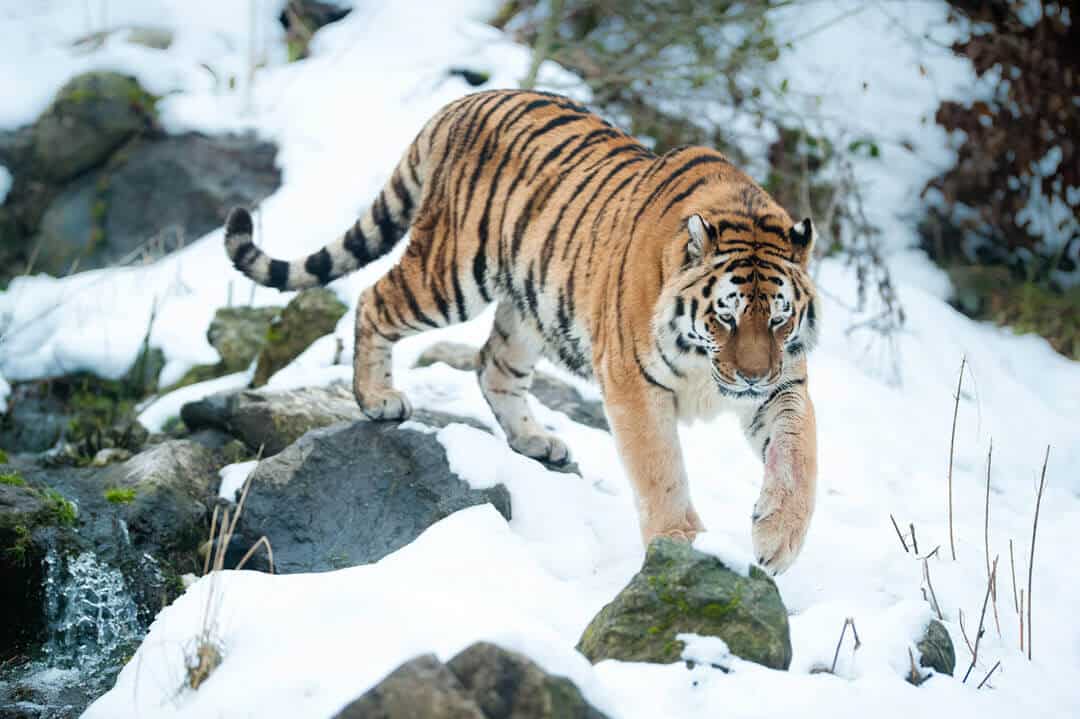
2. Bengal Tiger (Panthera tigris tigris)
The Bengal tiger is slightly smaller than its Siberian cousin but still incredibly large. Found mainly in India, these tigers can weigh around 550 pounds and grow up to 11 feet long. They are known for their beautiful orange fur and dark stripes. Bengal tigers have powerful muscles to jump and run quickly, helping them hunt large prey. Cubs reach almost full adult size by 18 months and are fully grown by two years old.
Size Differences Between Males and Females
Bengal tiger males are notably larger than females. Here’s a comparison of their typical size differences:
Male Bengal Tiger:
- Weight: 180–260 kg (397–573 lbs)
- Body Length (head to tail): 2.7–3.1 meters (8.9–10.2 feet)
- Shoulder Height: 90–110 cm (35–43 inches)
- Tail Length: 85–110 cm (33–43 inches)
Female Bengal Tiger:
- Weight: 100–160 kg (220–353 lbs)
- Body Length (head to tail): 2.4–2.7 meters (7.9–8.9 feet)
- Shoulder Height: 75–95 cm (30–37 inches)
- Tail Length: 80–100 cm (31–39 inches)
Males can be up to 1.5 times heavier than females, and are generally longer and taller with a more muscular build. Males also have a broader head and thicker neck.
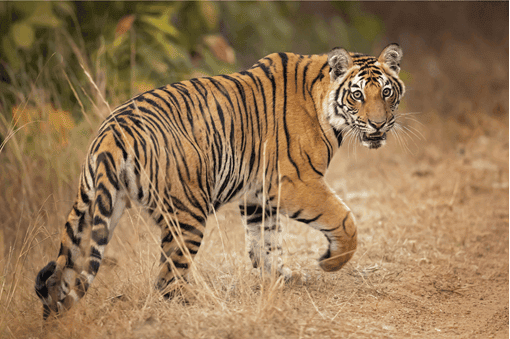
3. African Lion (Panthera leo)
These cats live in the savannas and grasslands of sub-Saharan Africa. African lions can weigh up to 550 pounds and reach lengths of around 10 feet. Their iconic mane, more prominent in males, signals health and maturity. They hunt large prey like buffalo, zebras, and antelopes, often in prides where females do most of the hunting. Females reach maturity at around 3 to 4 years of age, while males mature at around 4 to 5 years.
Size Differences Between Male and Female African Lions
African lion males are significantly larger and heavier than females. They are built for defending territory and pride leadership. Here’s a comparison:
Male African Lion:
- Weight: 150–250 kg (330–550 lbs), with some reaching up to 270 kg (595 lbs).
- Body Length (head to tail): 2.4–3.3 m (7.9–10.8 ft).
- Shoulder Height: 100–120 cm (39–47 inches) on average.
- Tail Length: 90–105 cm (35–41 inches).
Female African Lion:
- Weight: 110–180 kg (243–397 lbs).
- Body Length (head to tail): 2.3–2.7 m (7.5–8.9 ft).
- Shoulder Height: 90–110 cm (35–43 inches) on average.
- Tail Length: 70–100 cm (28–39 inches).
Males are often 1.4 to 1.5 times heavier than females, with a muscular build, broader heads, and a thick mane that can vary from light to dark. Females are more agile and focus on cooperative hunting to feed the pride.
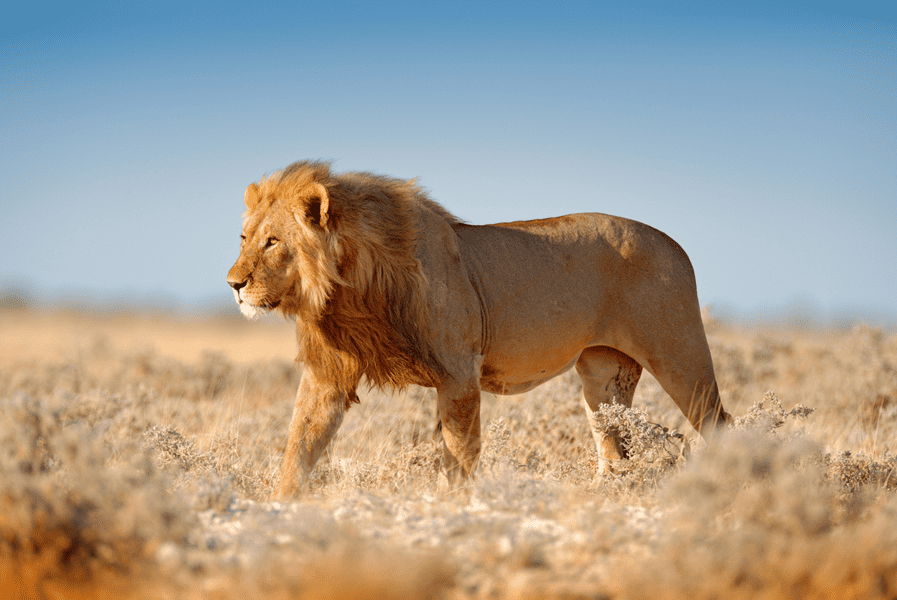
4. Asiatic Lion (Panthera leo persica)
These cats live in the dry deciduous forests of Gujarat, India, mainly in Gir Forest National Park. Asiatic lions can weigh up to 420 pounds and reach lengths of around 9 feet. Their thinner mane compared to African lions and a distinctive belly fold help identify them. They hunt deer, antelope, and wild boar, often in small prides. Females reach maturity at around 3 to 4 years of age, while males mature at around 5 years.
Asiatic lion males are larger and heavier than females, with a more robust build to defend their pride. Here’s a comparison:
Male Asiatic Lion:
- Weight: 120–190 kg (265–420 lbs), with some reaching up to 200 kg (440 lbs).
- Body Length (head to tail): 2.3–2.8 m (7.5–9.2 ft).
- Shoulder Height: 100–110 cm (39–43 inches) on average.
- Tail Length: 80–100 cm (31–39 inches).
Female Asiatic Lion:
- Weight: 80–120 kg (175–265 lbs).
- Body Length (head to tail): 2.0–2.4 m (6.6–7.9 ft).
- Shoulder Height: 90–100 cm (35–39 inches) on average.
- Tail Length: 70–90 cm (28–35 inches).
Males are often 1.5 times heavier than females, with broader heads and a visible mane, though less full than an African lion’s. Females are smaller and more agile, which makes it easier for them to hunt for the pride.
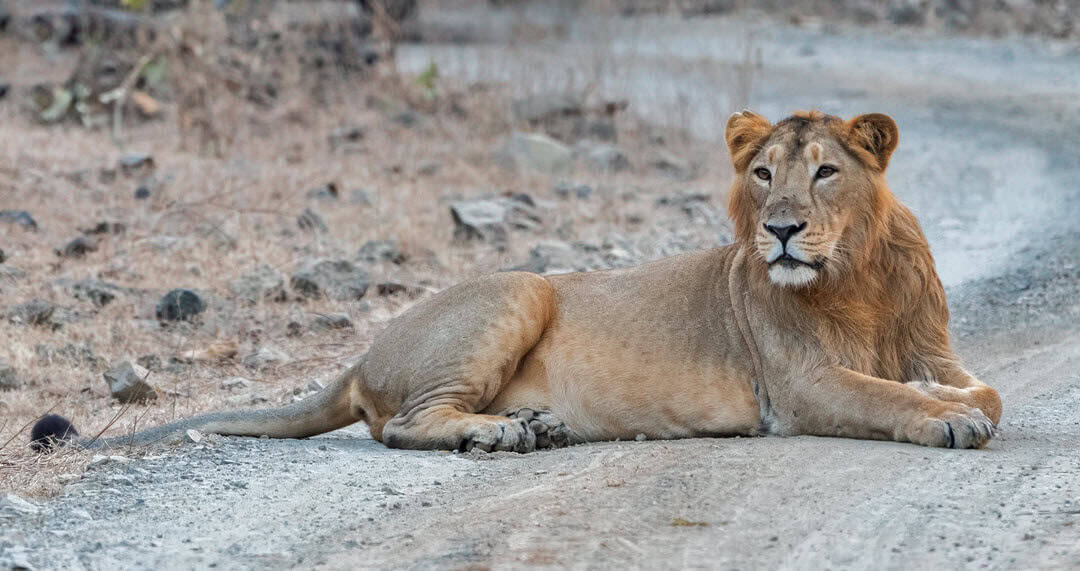
5. Indochinese Tiger (Panthera tigris corbetti)
These cats live in the forests, grasslands, and swamps of mainland Southeast Asia, including Cambodia, Laos, and Thailand. Indochinese tigers can weigh up to 430 pounds and reach lengths of around 9 feet. Their slightly lighter coat with narrower stripes compared to Bengal tigers helps them blend into their environment. They hunt deer, wild boar, and occasionally smaller elephants, preferring solitary ambushes. Females reach maturity at around 3 to 4 years of age, while males mature at around 4 to 5 years.
Size Differences Between Male and Female Indochinese Tigers
Indochinese tiger males are larger and heavier than females, designed for territorial dominance and taking down large prey. Here’s a comparison:
Male Indochinese Tiger:
-
Weight: 120–195 kg (265–430 lbs), with some reaching up to 200 kg (440 lbs).
-
Body Length (head to tail): 2.4–2.8 m (7.9–9.2 ft).
-
Shoulder Height: 90–100 cm (35–39 inches) on average.
-
Tail Length: 80–100 cm (31–39 inches).
Female Indochinese Tiger:
-
Weight: 80–110 kg (176–243 lbs).
-
Body Length (head to tail): 2.2–2.5 m (7.2–8.2 ft).
-
Shoulder Height: 80–90 cm (31–35 inches) on average.
-
Tail Length: 70–90 cm (28–35 inches).
Males are typically 1.5 times heavier than females, with a more robust frame and longer canines for hunting and fighting. Females are more slender, aiding in stealthy ambushes and raising cubs in dense habitats.
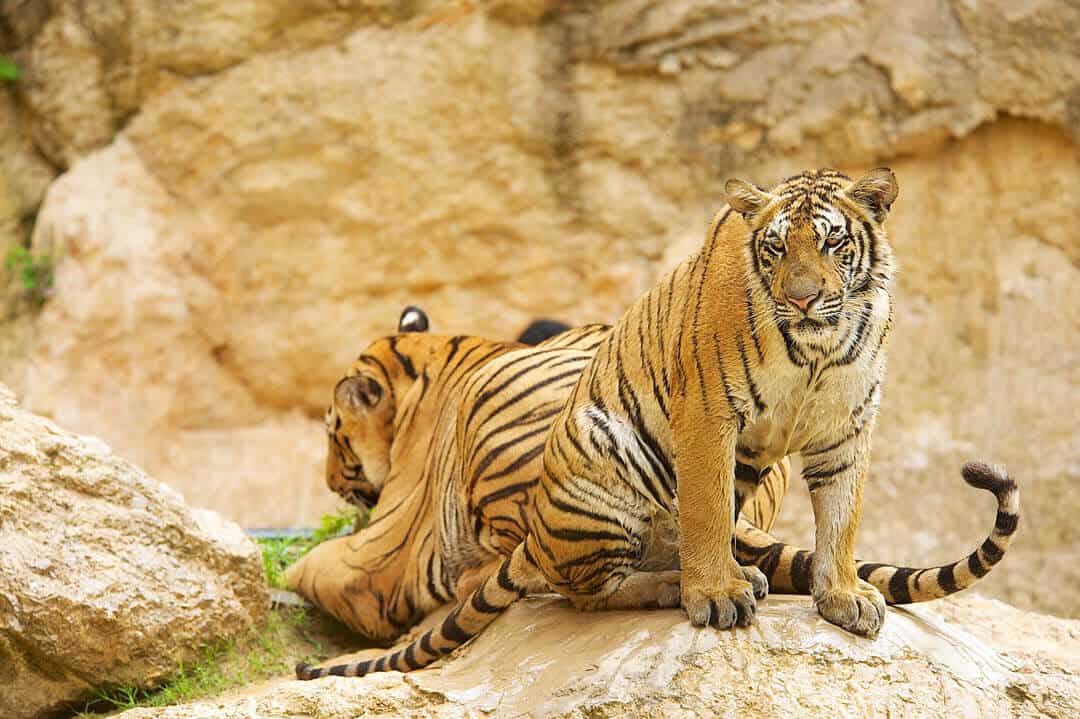
6. Malayan Tiger
These cats live in the tropical rainforests and wetlands of the southern Malay Peninsula, including Malaysia and southern Thailand. Malayan tigers can weigh up to 265 pounds and reach lengths of around 8 feet. Their darker orange coat and shorter stripes distinguish them from other tigers. They hunt deer, wild boar, and smaller mammals, often ambushing prey in dense forests. Females reach maturity at around 3 to 4 years of age, while males mature at around 4 to 5 years.
Size Differences Between Male and Female Malayan Tigers
Malayan tiger males are larger and heavier than females, built for territorial defense and hunting larger prey. Here’s a comparison:
Male Malayan Tiger:
- Weight: 80–120 kg (175–265 lbs), with some reaching up to 130 kg (287 lbs).
- Body Length (head to tail): 2.0–2.4 m (6.6–7.9 ft).
- Shoulder Height: 80–90 cm (31–35 inches) on average.
- Tail Length: 80–100 cm (31–39 inches).
Female Malayan Tiger:
- Weight: 50–80 kg (110–175 lbs).
- Body Length (head to tail): 1.8–2.1 m (5.9–6.9 ft).
- Shoulder Height: 70–80 cm (28–31 inches) on average.
- Tail Length: 70–90 cm (28–35 inches).
Males are typically 1.5 times heavier than females, with longer canines and a more muscular build. Females are more slender, aiding in stealthy hunting and caring for cubs in dense forest environments.
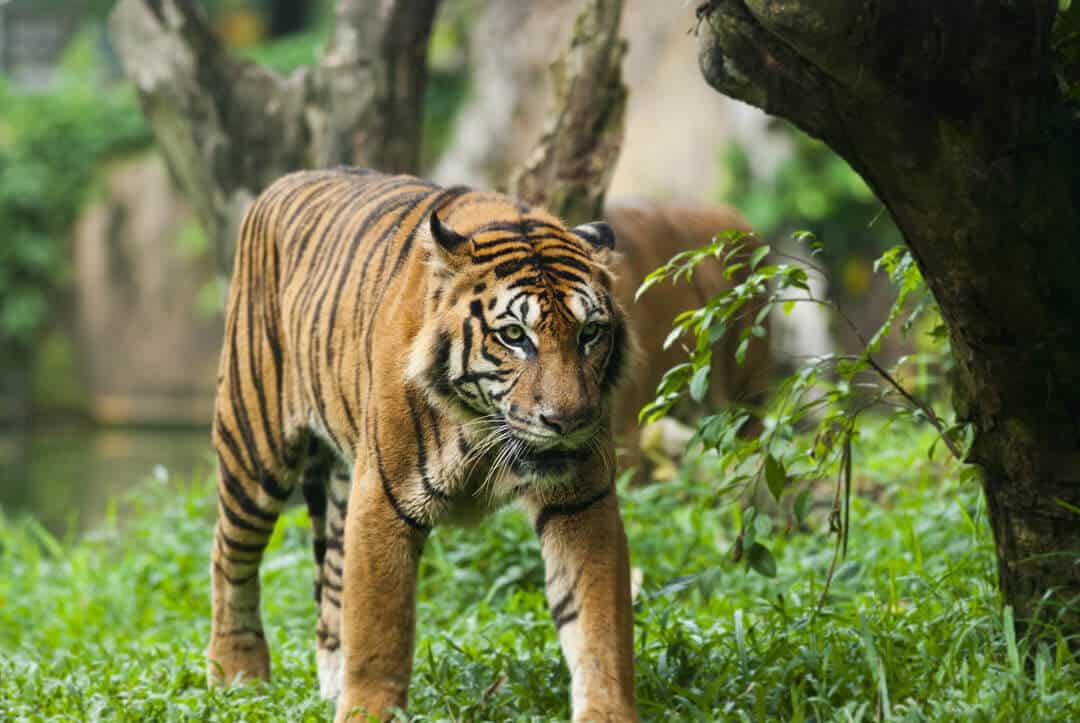
7. Sumatran Tiger (Panthera tigris sumatrae)
These cats live in the tropical rainforests, peat swamps, and montane forests of Sumatra, Indonesia. Sumatran tigers, the smallest tiger subspecies, can weigh up to 310 pounds and reach lengths of around 8 feet. Their darker orange coat with denser, narrower stripes and bearded appearance (especially in males) set them apart from other tigers. They hunt deer, wild boar, and smaller prey. Females reach maturity at around 3 to 4 years of age, while males mature at around 4 to 5 years.
Size Differences Between Male and Female Sumatran Tigers
Sumatran tiger males are larger and heavier than females, equipped for territorial patrols and hunting. Here’s a comparison:
Male Sumatran Tiger:
- Weight: 90–140 kg (200–310 lbs), with some reaching up to 150 kg (330 lbs).
- Body Length (head to tail): 2.1–2.5 m (6.9–8.2 ft).
- Shoulder Height: 80–90 cm (31–35 inches) on average.
- Tail Length: 80–100 cm (31–39 inches).
Female Sumatran Tiger:
- Weight: 65–90 kg (145–200 lbs).
- Body Length (head to tail): 1.9–2.2 m (6.2–7.2 ft).
- Shoulder Height: 70–80 cm (28–31 inches) on average.
- Tail Length: 70–90 cm (28–35 inches).
Males are about 1.5 times heavier than females, with a more robust frame and often a “bearded” look due to facial ruff. Females are lighter and more agile, helping them navigate Sumatra’s dense forests to hunt and raise cubs.
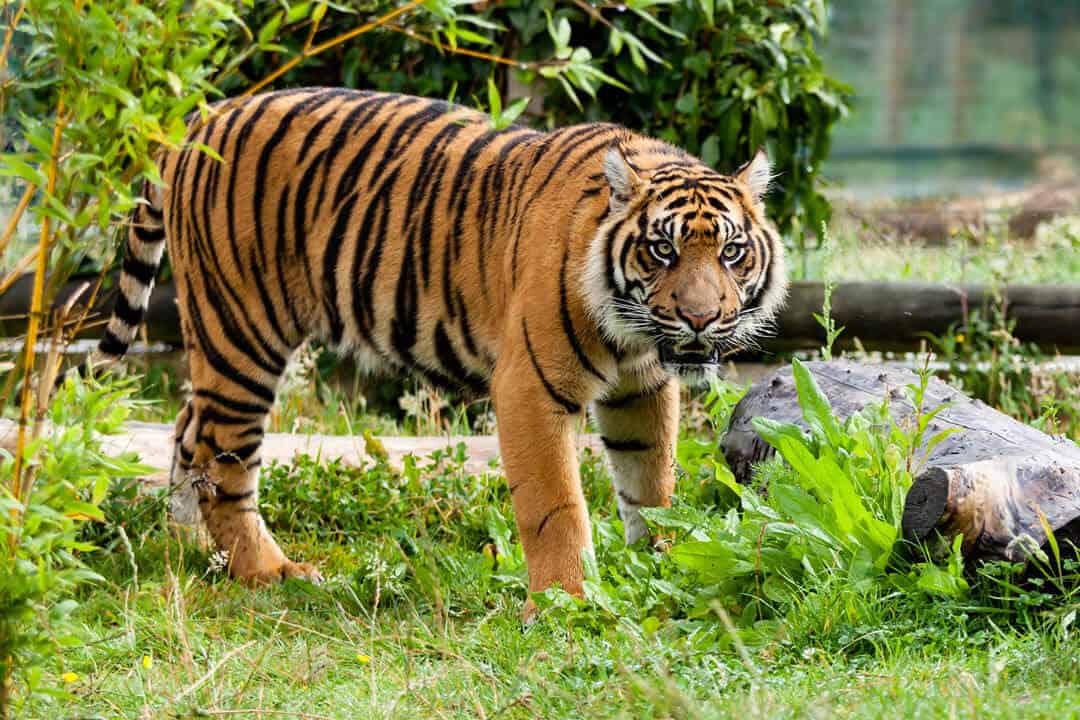
8. Jaguar (Panthera onca)
The jaguar is the largest big cat in the Americas. It weighs up to 350 pounds and can grow about 7.5 feet in length (body plus tail). The Jaguars’ strong jaws can crush the bones of their prey, making them powerful hunters. Cubs reach adult size by two to three years old and quickly become skilled hunters.
Size Differences Between Males and Females
Male jaguars are around 50 pounds heavier than females, which gives them a better chance of capturing larger prey and defending their territory.
Male Jaguar:
- Weight: 90–120 kg (198–264 lbs), with some reaching up to 150 kg (330 lbs).
- Body Length (head to tail): 1.6–1.85 meters (5.2–6.1 feet).
- Shoulder Height: 75–80 cm (30–31 inches).
- Tail Length: 70–90 cm (28–35 inches).
Female Jaguar:
- Weight: 60–100 kg (132–220 lbs).
- Body Length (head to tail): 1.4–1.7 meters (4.6–5.6 feet).
- Shoulder Height: 65–75 cm (26–30 inches).
- Tail Length: 60–80 cm (24–31 inches).
Males are usually 25 to 50% heavier than females, with a broader head and more muscular build. Females are more slender and agile. Males tend to have larger territories, while females focus on areas best for cub-rearing.
Find out more about jaguar physical characteristics and behavior.
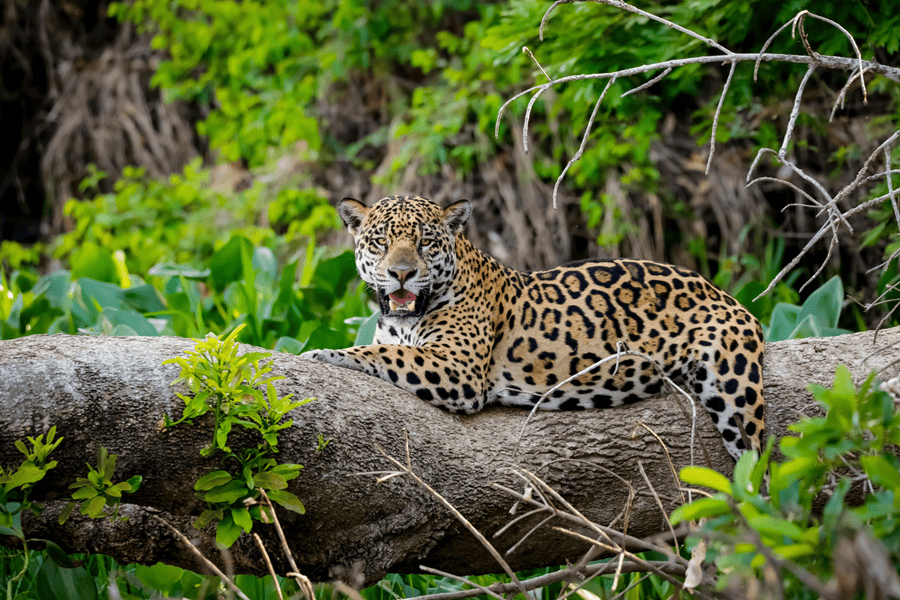
9. Cougar (Mountain Lion) (Puma concolor)
Cougars weigh about 220 pounds and can be up to 8 feet long. They live in North and South America and are excellent at jumping and climbing. Cougars have powerful legs, allowing them to leap distances up to 20 feet. Cougar cubs grow quickly and become fully grown adults by two years old.
Size Differences Between Males and Females
Male cougars are typically larger, weighing about 30-50 pounds more, helpful for territory control.
Male Cougar:
- Weight: 53–100 kg (117–220 lbs), with some reaching up to 120 kg (265 lbs).
- Body Length (head to tail): 2.4–2.75 meters (7.9–9 feet).
- Shoulder Height: 60–90 cm (24–35 inches).
- Tail Length: 60–95 cm (24–37 inches).
Female Cougar:
- Weight: 29–64 kg (64–141 lbs).
- Body Length (head to tail): 2.0–2.3 meters (6.6–7.5 feet).
- Shoulder Height: 50–75 cm (20–30 inches).
- Tail Length: 50–85 cm (20–33 inches).
Males are longer and taller than females, with a more robust and muscular appearance.

10. Leopard (African Lion) (Panthera pardus)
Leopards are smaller than jaguars, but they are powerful and strong. A large leopard weighs about 200 pounds and can grow up to 7 feet long. They live in Africa and Asia and are great climbers, often carrying their prey up trees to keep it safe from scavengers. They eat smaller animals like monkeys, birds, and deer. Female leopard cubs reach maturity at about 2 to 3 years old, and males at around 3 to 4 years old.
Size Difference Between Male and Female Leopards
Male leopards are generally larger and heavier than female leopards. Here’s a comparison of their typical size differences:
Male Leopards:
- Weight: 40–90 kg (88–198 lbs), with some large individuals reaching up to 100 kg (220 lbs).
- Body Length (head to tail): 1.2–1.9 meters (4–6.2 feet).
- Shoulder Height: 60–80 cm (24–31 inches).
Female Leopards:
- Weight: 28–60 kg (62–132 lbs).
- Body Length (head to tail): 1–1.7 meters (3.3–5.6 feet).
- Shoulder Height: 50–70 cm (20–28 inches).
Males are not only larger but also more muscular than females, with broader heads and thicker necks, which helps them compete for territory and mates. Females, on the other hand, tend to be more agile and slender.
Learn how to tell the difference between a jaguar and leopard.
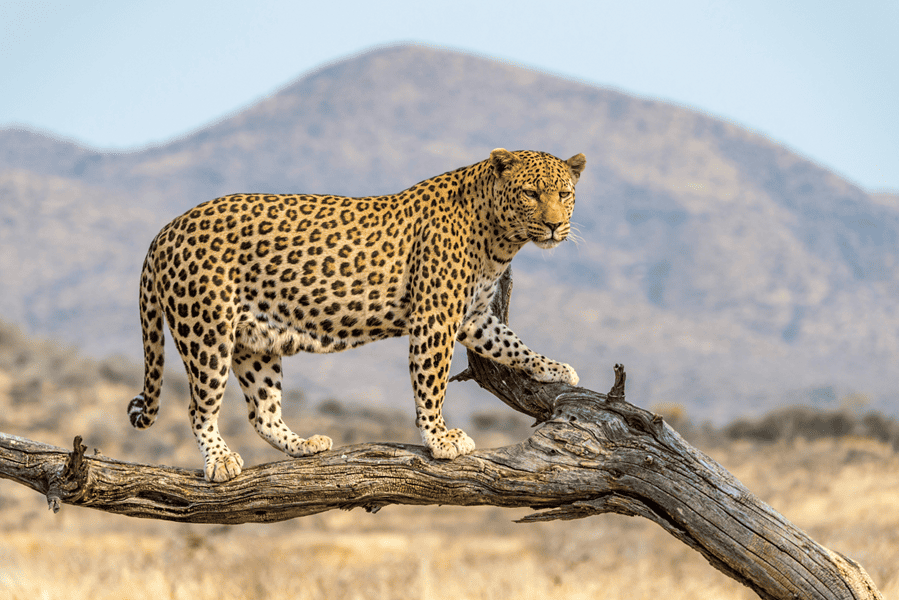
11. Snow Leopard (Panthera uncia)
These cats live in cold mountains in Central Asia. Snow leopards can weigh about 120 pounds and reach lengths of around 7 feet. Their thick fur and wide paws help them survive in snowy environments. Snow leopards hunt sheep, goats, and smaller animals. They eat slowly and can survive on a single large prey for days. Their size and powerful legs allow them to leap long distances, helping them catch prey in rocky terrain. Female snow leopard cubs reach maturity at around 2 to 3 years of age. Males reach maturity at around 4 years of age.
Size Differences Between Male and Female Snow Leopards
Snow leopard males are larger and heavier than females, but the difference is not as extreme as in some other big cat species. Here’s a comparison:
Male Snow Leopard:
- Weight: 45–55 kg (99–121 lbs), with some reaching up to 75 kg (165 lbs).
- Body Length (head to tail): 1.1–1.3 meters (3.6–4.3 feet).
- Shoulder Height: 60 cm (24 inches) on average.
- Tail Length: 80–105 cm (31–41 inches).
Female Snow Leopard:
- Weight: 32–40 kg (71–88 lbs).
- Body Length (head to tail): 0.9–1.15 meters (3.0–3.8 feet).
- Shoulder Height: 55 cm (22 inches) on average.
- Tail Length: 75–100 cm (30–39 inches)
Males are often 1.5 times heavier than females, with longer bodies and a broader head. Females are more slender and agile, which helps them raise cubs and navigate steep mountainous terrain.
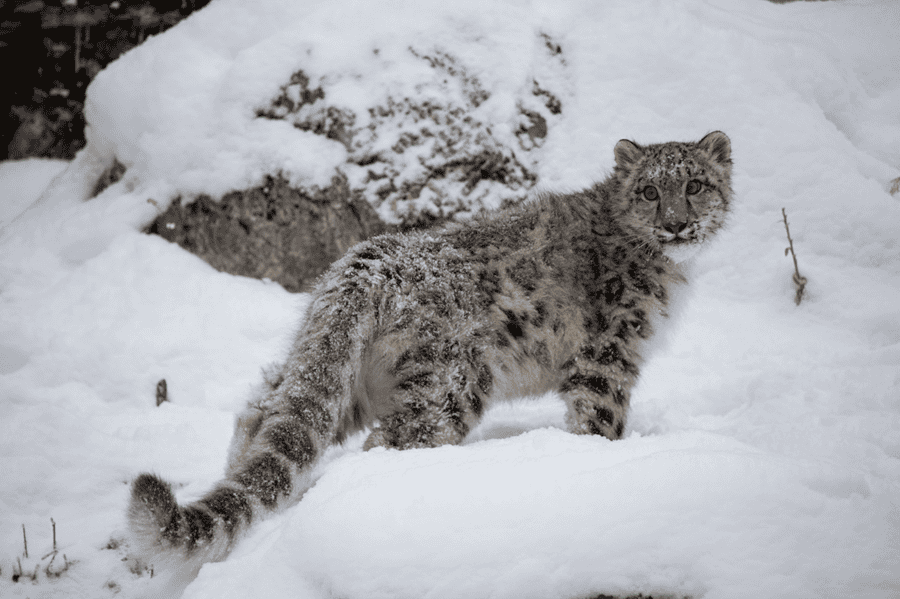

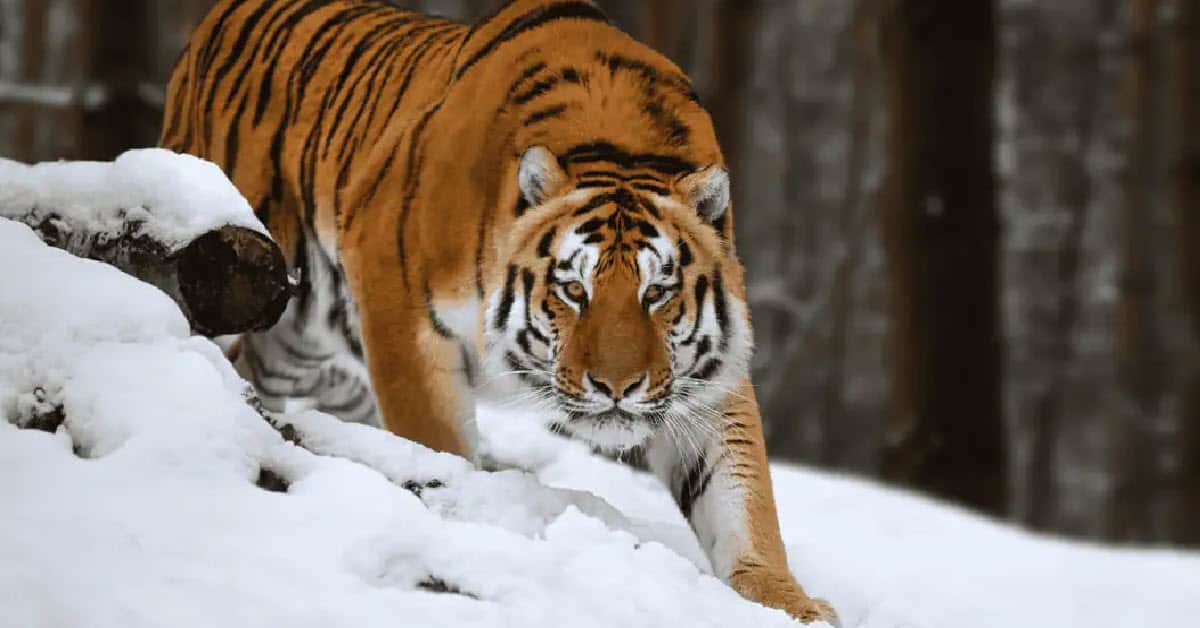
0 Comments